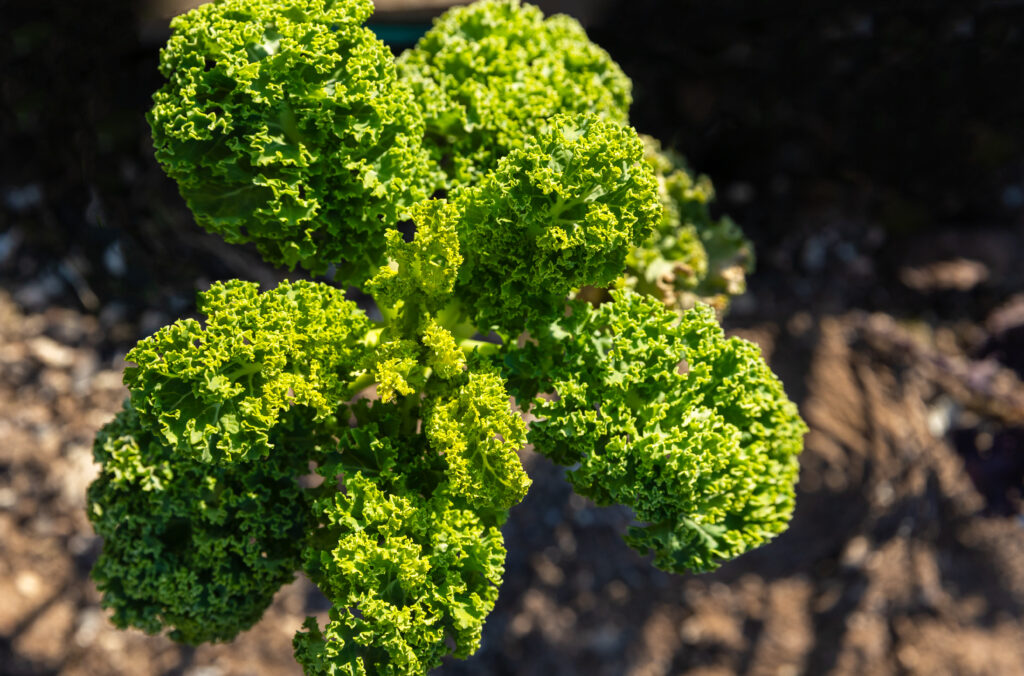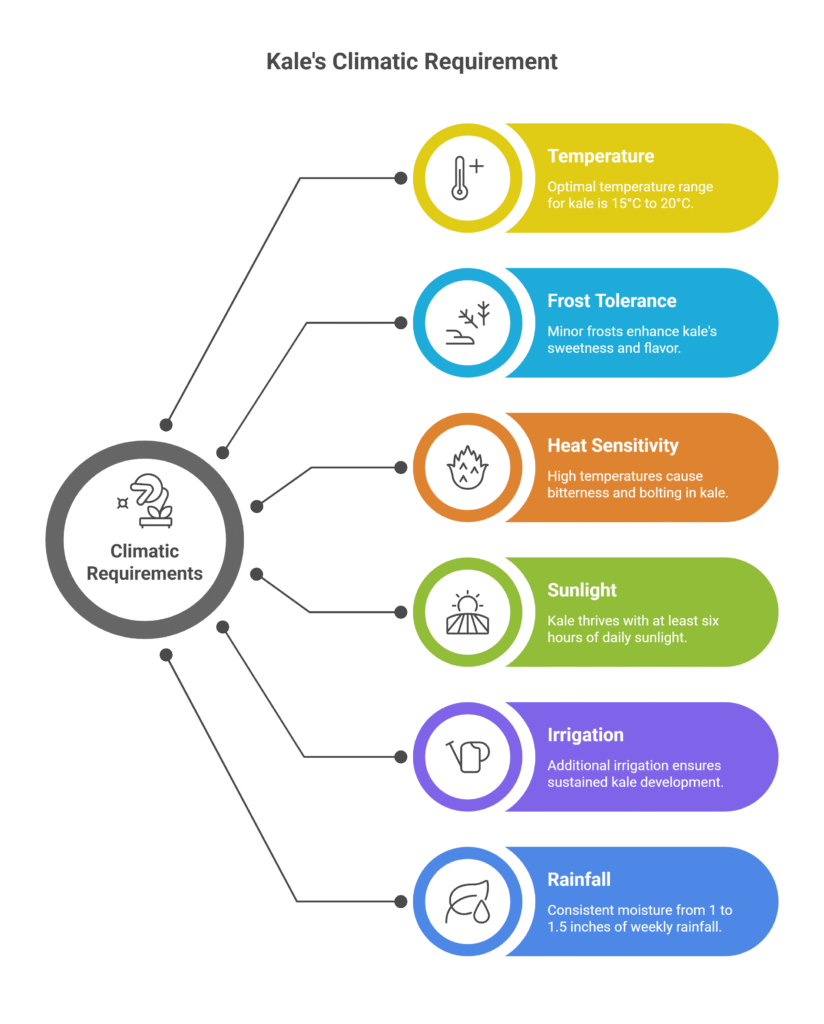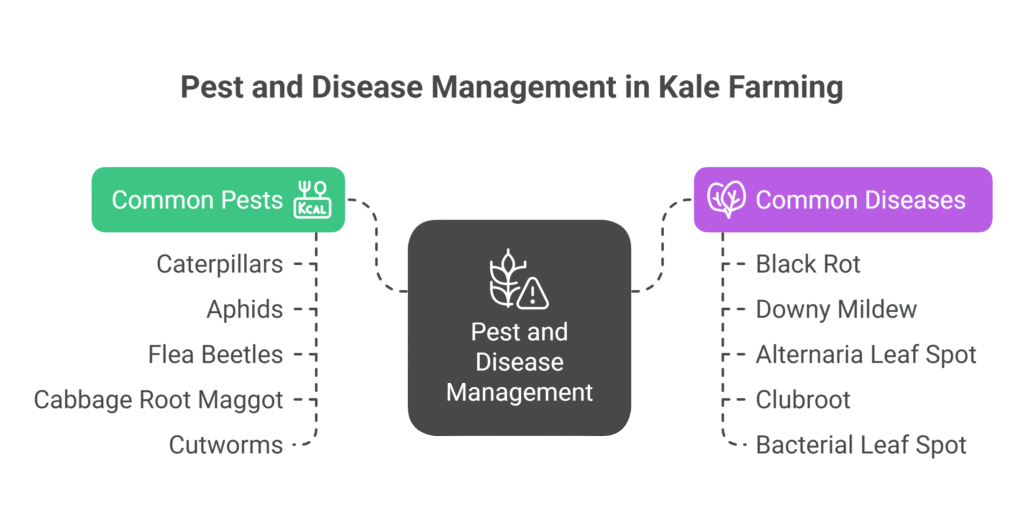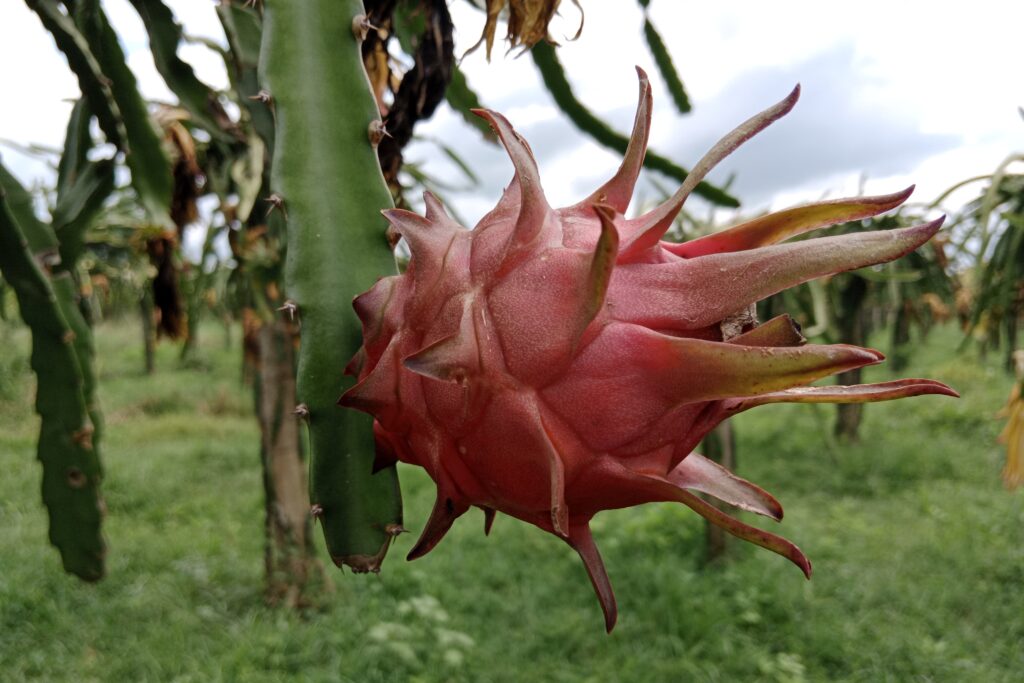Kale Farming
A leafy green vegetable rich in nutrients, kale is a member of the Brassicaceae family, which also includes broccoli and cabbage. It is popular in healthy diets because it is high in antioxidants, calcium, and vitamins A, C, and K. Its soft leaves are perfect for smoothies, salads, and cooking. Kale may be picked repeatedly utilizing the cut-and-come-again method and grow well in cooler areas.

Kale farming profit per acre demonstrates exceptional economic potential, with a total income of NRs 240,000 generated from the sale of fresh leaves at NRs 20/kg. Against total production costs of NRs 53,000, this highly lucrative crop delivers a net profit of NRs 187,000 per acre.
The operation achieves remarkable efficiency through a 77.92% profit margin, meaning nearly 78% of revenue translates directly to profit. Most significantly, it realizes an extraordinary 353% return on investment (ROI) – equivalent to earning NRs 3.53 for every rupee invested. These metrics collectively underscore kale farming’s strong viability as a high-return agricultural enterprise under the given cost and market conditions.

Land Preparation
To prepare the field, first clear it of any previous crop residues, rocks, and large debris, then perform deep plowing to a depth of 8–12 inches to loosen the soil and enhance aeration and drainage. Follow this with 2–3 rounds of harrowing or rototilling to break up soil clods and create a smooth, fine tilth. Next, level the field to ensure uniform water distribution, and finally incorporate well-decomposed organic matter such as farmyard manure (FYM) or compost during the last tilling for improved soil fertility and structure.
Soil Type
The crop grows best in well-drained, fertile loam or sandy loam soils rich in organic matter, with a preferred pH range of 6.0 to 7.0; soils with a pH below 5.5 should be limed. Good drainage is essential, as poorly drained conditions can cause root rot diseases, and in heavy soils, raised beds are recommended to improve water movement and prevent waterlogging.
Climatic Requirements
The ideal growing temperature range for this cool-season crop is 15°C to 20°C (60°F to 70°F). It can withstand minor frosts, which can increase sweetness, but it has a limited tolerance to heat; extended exposure to temperatures above 26°C (80°F) causes bitterness, toughness, and bolting.
Although it can withstand little shadow in hotter climes, it loves to be in full sun for at least six hours per day. A well-distributed rainfall of 1 to 1.5 inches per week is excellent for maintaining consistent moisture, and additional irrigation is frequently needed to sustain ideal development.

Major Cultivars
Major kale cultivars are classified based on leaf type—curly, flat/Tuscan, or ornamental—and their maturity time, with each type offering distinct textures, flavors, and uses.
| Common Name | Example Cultivars | Key Features | Special Attributes |
| Curly Kale | ‘Winterbor’, ‘Dwarf Blue Curled Scotch’, ‘Starbor’ | Ruffled/curled leaves | Most common type; Very cold-hardy |
| Lacinato (Tuscan/Dinosaur Kale) | ‘Nero di Toscana’, ‘Black Magic’ | Long, narrow, bumpy (“dino-skin”), dark blue-green leaves | Tender texture |
| Red Russian Kale | ‘Red Russian’ | Flat, fringed/feathered leaves; Purple veins/stems | Sweeter, tender flavor; Less cold-hardy |
| Ornamental Kale | Bred for color/variety | Colorful (pinks, purples, whites), highly frilly leaves | Edible but often tougher; Primarily decorative |
| Others | ‘Premier’, ‘Beira’, ‘Thousandhead’ | Varies by cultivar | Choose based on local climate, market & disease resistance |
Propagation
Kale is primarily propagated from seeds, with direct seeding being the most common method; however, it can also be started in nursery trays or plugs and later transplanted to achieve uniform stands or extend the growing season.
Seed Rate per Acre
For direct seeding, the recommended seed rate is about 400–600 grams per acre, while for transplanting (to raise seedlings), it is around 100–200 grams per acre.
Nursery Management
The nursery should be established in a plot that has not grown crops from the Brassicaceae family for at least three years to prevent disease carryover. Prepare a seedbed about 1 m wide and of suitable length, making 2 cm deep drills spaced 10–15 cm apart. Sow seeds thinly in the drills, cover lightly with soil, and mulch if possible. Water seedlings regularly but avoid overwatering to prevent damping-off disease. Begin hardening seedlings 1–2 weeks before transplanting by gradually reducing watering and shade. Raising seedlings in pots can also be effective to prevent overgrowth in the nursery.
Planting
Planting Season
Kale is typically planted between mid-September and November, which provides optimal conditions for germination and growth.
Spacing
Row Spacing: 60 cm between rows.
Plant Spacing: 45 cm between plants within the row.
Planting Method
Direct Seeding
For direct seeding, sow seeds at a depth of ¼ to ½ inch (0.6–1.25 cm). Once the seedlings emerge, thin them to the recommended final spacing to ensure healthy growth and reduce competition for nutrients, water, and light.
Transplanting
Seeds should be started indoors four to six weeks prior to the intended transplant date. Before planting, gradually expose the seedlings to the outdoors to harden them off. Place seedlings in the tray at the same depth as they grow, and then gently press the dirt around them to encourage good root-to-soil contact after transplanting.
Number of Plants per Acre
Based on the above spacing, approximately 14,988 plants can be grown per acre.
Intercropping
Intercropping with compatible companions such as onions, garlic, herbs like dill, mint, rosemary, and sage, as well as beets, celery, potatoes, nasturtiums (as a trap crop), and marigolds (for nematode control) can maximize land use and offer benefits like pest and disease suppression, improved microclimate, and weed control; however, it is advisable to avoid planting other brassicas (cabbage, broccoli, cauliflower), strawberries, and tomatoes nearby due to shared pests and diseases.
Irrigation
Avoiding water stress is crucial for the development of sensitive leaves and the general growth of plants, as both depend on consistent soil moisture. Overhead sprinkling is less ideal since it can encourage illness, but drip irrigation is the recommended technique because it uses less water and reduces leaf moisture that can cause disease. Furrow irrigation is also utilized. Deep watering should normally be done once or twice a week, with a weekly watering goal of 1 to 1.5 inches. Sand soil or hot weather conditions call for more frequent, lighter watering.
Fertilizer and Manure
Conducting a soil test is essential to obtain precise recommendations for nutrient management, ensuring optimal soil fertility and crop productivity.
| Category | Component | Rate/Amount | Application Timing & Method |
| Baseline (per acre) | Organic Matter | 15-20 tons well-rotted Farm Yard Manure (FYM) or compost | Incorporated during land preparation |
| Biofertilizers | 1 kg/acre each of: • Azospirillum • Phosphorus-solubilizing bacteria (PSB) • Potassium-mobilizing bacteria | Applied during land preparation to enhance soil fertility and plant growth | |
| N-P-K Fertilizers | 80-100 kg N 50-60 kg P₂O₅ 50-60 kg K₂O | See application schedule below | |
| Application | Basal Dose (Pre-planting) | • Full P₂O₅ (50-60 kg) • Full K₂O (50-60 kg) • 1/3 to 1/2 of total N (27-50 kg) | Mixed with organic matter and applied before planting |
| Top Dressing | Remaining N (50-73 kg) | Applied in 1-2 splits: • First: 3-4 weeks after transplanting/during thinning • Second: 3-4 weeks later (if needed) Method: Side-dressed along rows |
Weed Control
Weed control is critical as weeds compete intensely with crops for water, nutrients, and light; effective methods include cultural practices like dense planting, mulching with organic or plastic materials, and the stale seedbed technique, as well as mechanical control through shallow cultivation or hoeing when weeds are small, taking care to avoid root damage; chemical control options are limited and generally used with caution, with pre-emergent herbicides applied only if registered for kale and post-emergent herbicides mostly avoided due to crop sensitivity, making cultural and mechanical methods the preferred approaches.
Inter Culture Operation
Pruning
To increase air circulation, lessen the danger of illness, and focus energy on new development, regular pruning entails removing lower leaves that are yellowed, diseased, or damaged and that touch the ground. While managing bolting entails pinching off developing flower stalks as soon as possible to lengthen the leaf harvest period—though bolted leaves tend to turn bitter—harvesting by picking lower leaves also functions as a type of trimming.
Flowering and Fruit Management
Flowering (Bolting)
Bolting, or premature flowering, is triggered by longer day lengths in spring and high temperatures. This process is undesirable for leaf production because it diverts the plant’s energy away from leaf growth toward flowering and seed production.
Management
To manage bolting, it is important to select slow-bolting cultivars and plant them at optimal times, avoiding late spring planting if a summer harvest is intended. Providing adequate water and mulch helps moderate soil temperature, reducing stress that can induce bolting. Additionally, flower stalks should be pinched off immediately when they appear to prolong leaf production.
Fruit
Kale is primarily grown for its leaves, not for fruit. Seeds are produced only if the plants are allowed to bolt and the flowers are permitted to mature, which is usually not desirable in leaf-focused cultivation.
Pest and Disease Management
Common Pests
Caterpillars
Common caterpillar pests such as cabbage loopers, imported cabbageworms, and diamondback moth larvae can be effectively managed using Bacillus thuringiensis (Bt) applied at 0.5–1 kg per acre (or 2–4 g per liter of water) every 7–10 days, or spinosad at 30–60 ml per acre (0.5–1 ml per liter of water) every 7–14 days. Non-chemical control methods include hand-picking larvae, using row covers to prevent moths from laying eggs, and encouraging natural predators like parasitic wasps and birds to keep pest populations under control.
Aphids
Aphids can be controlled using eco-friendly approaches that protect beneficial insects. Regular spraying with insecticidal soap (1–2% solution, 10–20 ml per liter of water, applied weekly) or neem oil (0.5–1% solution, 5–10 ml per liter, applied every 7–14 days) helps reduce populations effectively. Non-chemical methods include dislodging aphids with a strong stream of water and releasing natural predators like ladybugs or lacewings at a rate of 5,000–10,000 per acre to maintain long-term control.
Flea Beetles
Flea beetles can be managed effectively through both preventive and control measures. Using row covers at planting helps block adult beetles from reaching young seedlings. For active infestations, apply spinosad at 30–60 ml per acre (0.5–1 ml per liter of water) every 7–14 days, or neem oil at a 0.5–1% solution (5–10 ml per liter) weekly. As a natural deterrent, dust 10–20 kg of diatomaceous earth per acre on the soil surface, reapplying after rain. Combining these methods ensures both immediate control and long-term protection.
Cabbage Root Maggot
Cabbage root maggots can be controlled through an integrated approach combining cultural, biological, and physical methods. Rotating crops for at least two years away from brassicas help break the pest’s life cycle and reduce larval buildup in the soil.
Cutworms
Cutworms can be managed using a combination of physical, cultural, and biological controls. Placing cardboard or plastic collars around transplants, buried 2–3 cm deep, physically blocks larvae from cutting plant stems. Shallow soil cultivation helps disrupt their habitat and expose larvae to predators.

Common Diseases
Black Rot (Bacterial)
Black rot results in blackened veins and yellow, V-shaped lesions on the leaf margins. Since there is little control over chemicals, preventive is essential. Always use seeds that have been confirmed disease-free, or soak them in a solution of streptomycin sulfate (1 g in 1 L water for 30 minutes) or treat them with hot water at 50°C for 25 to 30 minutes. Plant resistant kinds, rotate your crops for two to three years, and steer clear of overhead irrigation to stop the spread of germs. Foliar fungicides are ineffective in treating this illness.
Downy Mildew (Oomycete)
This disease produces yellow angular spots on the top of leaves and grayish-white mold underneath in cool, humid conditions. Improve airflow by wider spacing and use resistant varieties. Apply chlorothalonil at 1.12–1.68 kg per acre or mancozeb at 1.68–2.24 kg per acre. Start applications preventively or at first symptoms and repeat every 7–10 days during wet conditions.
Alternaria Leaf Spot (Fungal)
Alternaria leaf spot appears as dark brown to black circular lesions with concentric rings, often starting on older leaves. Rotate away from crucifers for at least two years. Apply chlorothalonil at 1.12–1.68 kg per acre or mancozeb at 1.68–2.24 kg per acre preventively or at the first sign of disease. Repeat sprays every 7–14 days depending on disease severity and weather conditions.
Clubroot (Soil-borne)
Clubroot causes swollen, club-shaped roots and severe stunting, thriving in acidic soils. Rotate crops for at least seven years away from crucifers and lime the soil to a pH of 7.2 or higher based on soil test results. No effective fungicide sprays exist for established plants. Pre-plant soil application of fluazinam at 0.56 L per acre may help reduce disease in high-risk areas, but it is costly and should only be used per label guidelines.
Bacterial Leaf Spot (Bacterial)
This disease starts as small, dark, water-soaked spots that turn angular and brittle. Control it with crop rotation, drip irrigation instead of overhead watering, and sanitation. Apply copper hydroxide at 0.84–1.96 kg per acre. Start sprays at the first symptom and repeat every 7–10 days, especially during wet periods. Tank-mixing with mancozeb may improve control.
Harvesting
Kale can be harvested once leaves reach usable size—about 8–10 inches long for full-sized varieties or earlier for baby kale—typically 55–75 days after planting for mature leaves. For a continuous supply, use the cut-and-come-again method by removing outer, lower leaves 2 inches above the main stalk with a sharp knife or shears, leaving the central bud intact for regrowth.
Alternatively, whole plant harvesting—cutting at the base—is used for baby kale or at season’s end. Harvest 1–2 times weekly to encourage fresh growth, maintain tenderness, and avoid bitterness, with the best flavor achieved in cool weather, especially after a light frost.
Yield
Kale yields vary widely depending on cultivar, climate, season, management practices, and harvest duration. Under good management and using the cut-and-come-again method for mature leaf production, typical seasonal yields range from 10 to 20 tons per acre.
Cost of Investment per Acre for Kale Farming
| S.N. | Categories | Cost (NRs.) |
| 1 | Land Preparation (plowing) | 15,000 |
| 2 | Seed | 2,000 |
| 3 | Nursery Management | 5,000 |
| 4 | Transplanting | 3,000 |
| 5 | Fertilizers and Manure | 8,000 |
| 6 | Irrigation | 5,000 |
| 7 | Weed Control (pre & post-emergence) | 2,000 |
| 8 | Pest & Disease Control | 3,000 |
| 9 | Harvesting | 5,000 |
| 10 | Miscellaneous Costs | 5,000 |
| Total Cost | 53,000 |
Income from per Acre Kale Farming
| Particulars | Estimated Yield / Acre (Kg) | Market Price (NRs. /Kg) | Total Income (NRs.) |
| Fresh Leaves Yield | 12,000 | 20 | 240,000 |
Analysis of Kale Farming Profit Per Acre
| Description | Amount (NRs.) |
| Total Income | 240,000 |
| Total Cost | 53,000 |
| Net Profit | 187,000 |
| Profit Margin | 77.92% |
| Return on Investment (ROI) | 353% |
Kale farming generates a total income of NRs 240,000 per acre from fresh leaf sales at NRs 20/kg. Against a total production cost of NRs 53,000, this yields a net profit of NRs 187,000. The operation demonstrates high efficiency with a profit margin of 77.92%, meaning nearly 78% of income translates to profit. Most notably, it achieves a 353% return on investment (ROI), indicating every rupee invested yields a return of NRs 3.53, underscoring its strong economic viability.
Crop Calendar (Per Acre Basis)
| Phase | Autumn-Winter Crop (Primary Season) | Late Winter-Spring Crop (Secondary Season) | Key Activities & Notes |
| Land Preparation | Mid-August | Early January | Clear debris, deep plow (8-12″), harrow 2-3x, level field. Apply 15-20 tons FYM/compost + lime (if pH <6.0). |
| Nursery Sowing | Early September | Late January | Sow seeds in disease-free beds (100-200g seeds/acre). Maintain moist soil, protect from heavy rain. |
| Transplanting | Early October | Late February | Transplant 4-6 week-old seedlings @ 45cm x 60cm spacing (14,988 plants/acre). Water immediately. |
| Basal Fertilization | During transplanting | During transplanting | Apply full P₂O₅ (50-60kg), full K₂O (50-60kg), and 1/3 N (27-50kg). Incorporate into soil. |
| Top Dressing (N) | 1st: Early November 2nd: Early December | 1st: Mid-March 2nd: Early April | Apply remaining N (50-73kg) in splits. Side-dress along rows. |
| Weed Control | Weekly until canopy closure | Weekly until canopy closure | Mulch post-transplanting. Shallow hoeing 2-3 weeks after transplanting. |
| Irrigation | 2x/week (Oct-Dec) Reduce if rainy | 3x/week (Mar-May) | Drip irrigation preferred (1-1.5 inches/week). Increase frequency in sandy soils/heat. |
| Pest/Disease Mgmt | Oct-Nov: Aphids, Flea beetles Dec: Black Rot (preventive) | Mar-Apr: Caterpillars, Downy Mildew | Preventive: Neem oil (0.5-1%) weekly. Curative: Bt for caterpillars (0.5-1kg/acre); Copper spray for bacterial diseases. |
| Harvesting | Mid-Dec to Late Feb | Mid-April to Early June | Start 55-75 days post-transplanting. Use cut-and-come-again method (harvest lower leaves 2x/week). Expected yield: 10-20 tons/acre. |
Sources
Food and Agriculture Organization (FAO)
Indian Council of Agricultural Research (ICAR)
Japan International Cooperation Agency (JICA)
University of California Agriculture & Natural Resources (UC ANR)
European Plant Protection Organization (EPPO)
Punjab Agricultural University (PAU)
Tamil Nadu Agriculture University (TNAU) – Agritech portal
Nepal Agricultural Research Council (NARC)
U.S. Department of Agriculture (USDA).
Disclaimer: This crop farming profits assume optimal conditions. Actual results may vary depending on climate, market prices, and farm management practices.


